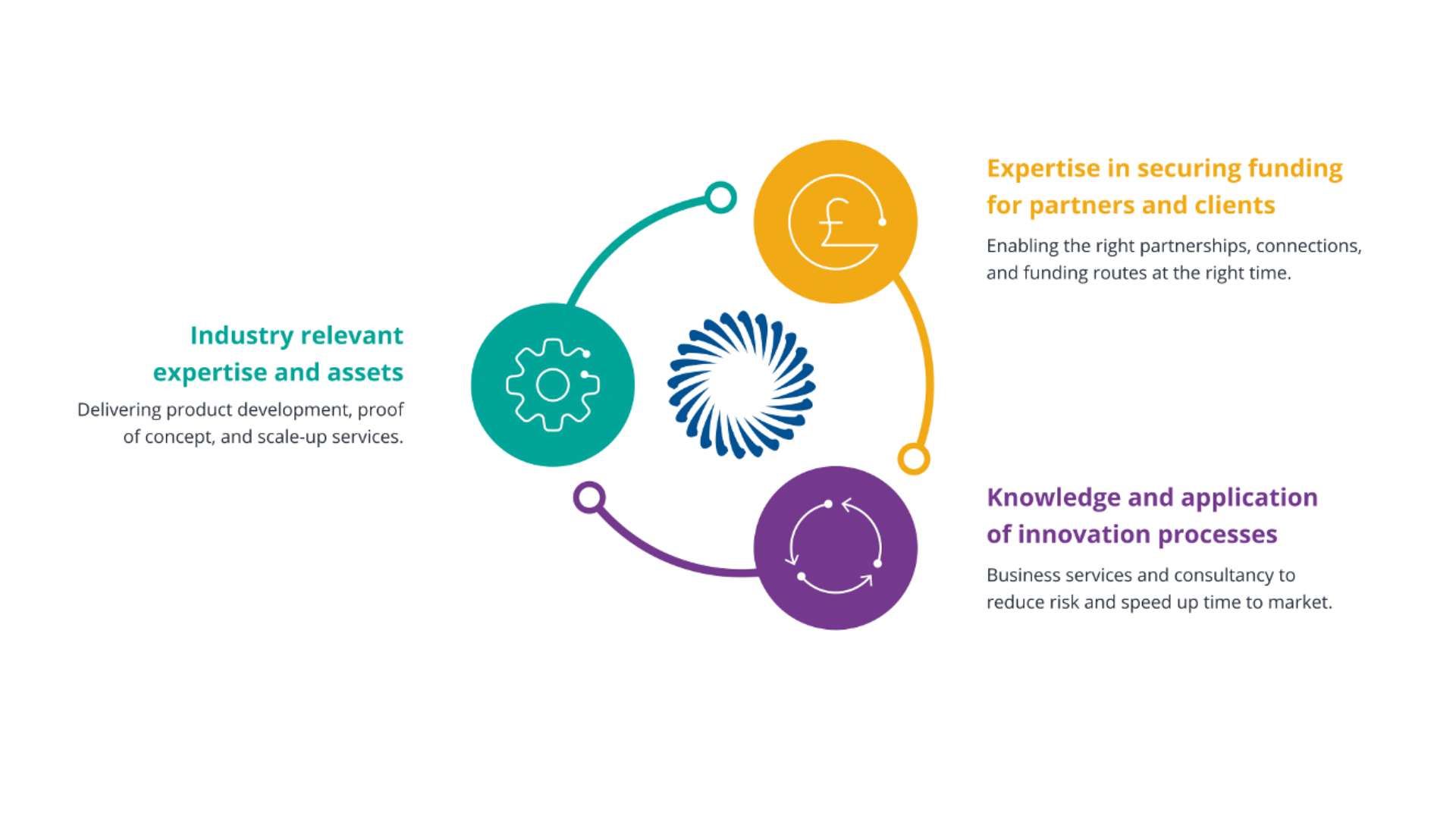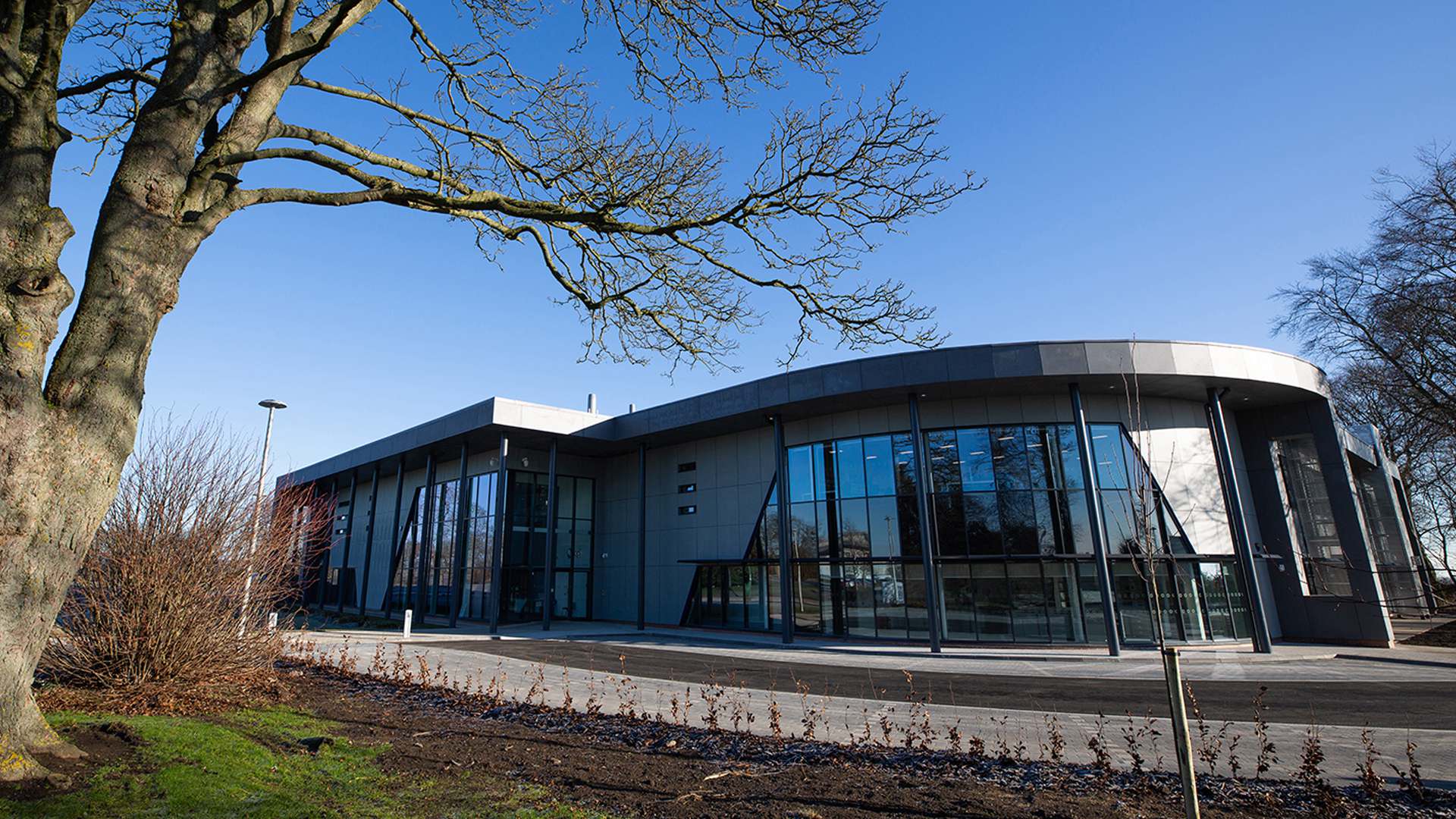Role of Innovation centres within deep tech ecosystems: A CPI perspective
We take a look at how innovation centres help navigate the frequent changes by embracing deep tech ecosystems.

Chief Strategy Officer
(he/him)

We are entering an era faced with unprecedented societal and industrial challenges, born from the burgeoning demands of our growing global population. We take a look at how innovation centres help navigate the frequent changes by embracing deep tech ecosystems.
Some of these challenges must be addressed imminently, such as the need for accessible and affordable healthcare, low carbon transport and the manufacturing of sustainable products for a circular economy.
Alongside these, we are also witnessing a set of global trends driving a profound shift in the way we deliver goods and services around the world. These trends are driven by rapid digital, technological and scientific advances that are converging across almost every sector. For example, the digitalisation of industries promises to radically reduce the cost and resources required to both manufacture and supply products. Artificial intelligence and machine learning will transform both e‑commerce and the personalisation of goods and services. Flexible and printable electronics are enabling a new range of wearable products and smart packaging, truly enabling the Internet of Things.
The far-reaching impact of the current COVID-19 pandemic has emphasised the importance of rapid and affordable healthcare, the need for co-ordinated and responsive supply chains, and agile business models to adapt to a significantly and rapidly changing global environment.
Disruptive and transformative innovations enabled by technological and scientific advances have a key role to play in solving our challenges and supporting Nations and industries to prepare for their journey to economic recovery. This presents a wealth of opportunities for small and medium-sized enterprises (SMEs) and large companies in both established and emerging industries to rise to each challenge and commercialise such innovations. In turn, this will improve our quality of life, contribute to a healthier society, cleaner environment and drive economic growth.
Deep tech could change the world
Many disruptive and transformative innovations are enabled by deep technologies (‘deep tech’) such as photonics, biotechnology, advanced materials, AI, robotics, nanotechnologies and flexible electronics. Deep tech enabled innovations have the potential to support established industries in addressing challenges around cost, environmental sustainability, resource inefficiencies and enhanced consumer demand. Not only this, they can also create entirely new industries of the future, delivering substantial societal and economic impact. As a result of such promise, private investment into the sector has soared. From 2015 to 2018, investment in deep tech grew at an average of 22% per year, totalling nearly $18 billion.

Deep tech’s Death Valley
Not everyone is aware of the challenge-strewn path that companies embarking on the deep tech innovation journey face. Organisations developing these deep tech innovations have begun to realise that it takes far longer and requires significantly more financing to move from basic science, research and invention through to development and commercialisation. Deep tech is therefore characterised by medium and long innovation cycles that can take anywhere from 4 to 12 years, from early prototyping to commercialisation. The challenge is more pronounced in highly regulated industries such as Pharmaceuticals and MedTech. This, together with heightened levels of uncertainty to succeed in unchartered spaces and the need for higher levels of investment, requires investors to balance the magnitude and timing of their investment and anticipated return.
An attempt to develop and supply deep tech-enabled disruptive innovations reveals the pitfalls of both the rigidity and unresponsiveness of our existing supply and value chains. Many large corporations have struggled to develop deep tech enabled disruptive innovations on their own. This is mainly attributed to their internal processes and resources being predominantly finetuned to develop incremental innovations that support their product portfolio. As a result, large corporations have heavily relied on acquiring innovations. Large corporations have also spun out companies, and in some cases created new corporate structures within their group to enable the more nimble and specialised innovation development. Some of these spinouts have then been brought back in-house, once the innovations have reached a certain level of maturity.
On the other hand, many academic spin outs and SMEs that have developed deep tech-enabled innovations have struggled to prove their technology, scale it up and demonstrate its market potential. In some circumstances, entirely new markets need to be created for their products. This requires access to data, labs, testing and scale-up infrastructure and production lines for emergent technology applications – all of which come at a significant cost.
Using our current system, we find ourselves stuck in deep tech’s Death Valley. Large corporations and SMEs are falling short of the mark, unable to adequately respond to deep tech’s new challenges and opportunities. The significant level of risk and uncertainty around the commercialisation of deep tech innovations reveals the need for a new approach to innovation development and commercialisation.

The need for a collaborative innovation ecosystem
To navigate deep tech innovations through Death Valley, players in this arena are beginning to adopt a much more collaborative approach. As elaborately articulated by Arnaud de la Tour and Massimo Portincaso in their paper, ‘The dawn of the deep tech ecosystem’: “Collaborative innovation ecosystems are forming with multiple actors coming together with a ‘win-win’ attitude, recognising the need for and benefits from a collaborative approach to develop and commercialise deep tech enabled innovations.” [1].
As such, collaborations are being forged between SMEs, mid-caps, large corporations, academia, industry bodies, incubators and accelerators, investors and innovation centres. Here, each participant works with a collaborative spirit and provides the specialist knowledge, expertise and funding necessary to accelerate the innovation development and commercialisation of deep technologies. This new deep tech ecosystem certainly presents a win-win opportunity for all players involved. Deep tech’s promise of significant societal and economic impact can therefore be realised, together with a financial ROI for investors.
Start-ups and SMEs play a major role as the originators of deep tech enabled innovations, with many originally stemming from academia, either through licensing or academic spinouts. Investors are continuing to monitor the opportunities and challenges associated with deep-tech investments. A recent article by Octopus Ventures explores the investment challenge in this ecosystem, given the small pool of investors who have the risk appetite for deep tech.[2]
The role of innovation centres within deep tech innovation ecosystems
Innovation centres occupy a vital space between academic and industrial research facilities at one end, with commercial scale manufacturing at the other. Innovation centres do not necessarily invent, but help translate promising technological research and inventions into commercial products. They have a focus on demonstrating the proof of concept and scale-up of new innovations as well as enabling market demonstration activities. The primary purpose of innovation centres is to provide capital- and resource-efficient access to expensive innovation facilities and expertise.
By providing the necessary capabilities in a pre-competitive mode, innovation centres allow each player in the ecosystem to collaborate and innovate together. They are of particular value when companies are developing disruptive and market-creating innovations within supply and value chains that are still nascent. In this state, the economic potential is latent, the revenue and business models are still forming and knowledge and skills are fragmented. Innovation centres can therefore bring clarity by joining the dots in a neutral and independent manner.
This premise led to CPI’s creation in 2004. Today, it is a leading deep tech innovation centre and a founding partner of the UK’s High Value Manufacturing Catapult. CPI has been acting as a key enabler and has supported SMEs, start-ups and large corporations with disruptive and market-creating innovations for over 15 years – translating novel research and inventions into clearly defined commercial products and processes.
A CPI Perspective
At CPI, it is our mission to ensure that every great invention gets the best opportunity to become a successfully marketed product or process. We understand that innovation is an intensely important, collaborative activity and we have reduced the risk for companies and investors and accelerated the time to market. You can read a number of Case Studies representing this.
CPI plays a critical role in helping organisations developing deep tech innovations in the UK and across the globe. We have £170m innovation facilities based in the North East of England and Scotland and over 450 scientists and engineers. Our capabilities include biotechnology, biotherapeutics, pharmaceutical processing, printable electronics, flexible hybrid electronics, photonics, and formulation and materials chemistry – all underpinned by a suite of digital capabilities.
The figure below depicts CPI’s unique proposition as a deep tech innovation centre. We engage with academia, academic spinouts, start-ups, SMEs and large corporates to enable disruptive, transformative, and in many cases, market-creating innovations.

Our flexible engagement model is combined with robust confidentiality and appropriate IP policies, allowing companies to work collaboratively and solve pressing industrial and societal challenges. This is achieved through innovation grant-funded collaborative programmes and privately funded contracts.
CPI’s 15 years of experience fostering such innovations has culminated in a innovation model called the Innovation Integrator®. This innovation diagnostic tool evaluates 11 factors that are critical for deep tech commercialisation and identifies any gaps that need to be addressed.
As an independent innovation centre, CPI allows companies from multiple industries to work together, in some cases even competing companies. Through our robust confidentiality and conflict management processes, we enable industry level innovations to be developed and deployed. A good example of CPI enabling transformative innovations within an established industry is at our Medicines Manufacturing Innovation Centre.
PragmatIC, a UK-based SME, is a world leader in the design and production of ultra-low-cost electronics. They have developed a unique, patented technology platform that provides the opportunity to invent entirely new applications for electronics, as well as extending proven applications e.g. RFID and NFC into use cases previously limited by the cost of silicon. Combining multiple material layers in a single ultra-low-cost process, their flexible integrated circuits (FlexICs) are easily embedded into everyday items, enabling the potential for trillions of smart objects. PragmatIC is also working with a range of companies who are developing their own FlexICs using their FlexIC Foundry™ service.
CPI has been supporting PragmatIC since 2012 by provision of access to innovation infrastructure and capabilities, which allowed PragmatIC to develop its technology and prove it as a complete end-to-end manufacturing process before it invested in its own equipment.

Summary
Deep tech enabled innovations have the potential to address our major global societal and industrial challenges and profoundly improve our lives. However, thanks to high capital investment requirements, lengthy innovation cycles and significant technological risks, very few companies can take this innovation journey on their own.
We are witnessing a shift towards a new and collaborative approach for developing and commercialising deep tech innovations. Here, innovation centres are increasingly taking on a key enabling and catalytic role by uniting SMEs, large corporates, academia, and investors together to accelerate innovation development and commercialisation.
References
[1] Portincaso. M, de la Tour. A, Soussan. P, (2019), The Dawn of the Deep Tech Ecosystem, Boston Consulting Group (BCG), viewed 13th February 2020.
[2] Octopus Ventures, (Dec 2019), Deep tech: moving beyond the lean start up model, Octopus Ventures, viewed 13th March 2020.
https://octopusventures.com/insights/the-lean-startup-model
Enjoyed this article? Keep reading more expert insights...
CPI ensures that great inventions gets the best opportunity to become a successfully marketed product or process. We provide industry-relevant expertise and assets, supporting proof of concept and scale up services for the development of your innovative products and processes.